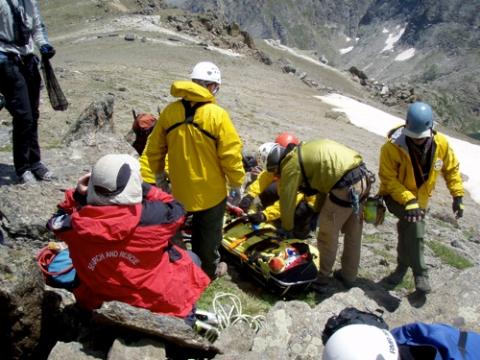A hiker at Rocky Mountain National Park suffered a broken leg in a fall in the park's backcountry on Saturday, August 8. He and rangers spent the night on a rocky slope above 12,000 feet before he was flown to a Denver hospital on Sunday.
The Grand County Sheriff's Department received a 911 call at about 1:30 p.m. on Saturday, reporting that a 32-year-old man was injured after a fall of about 20 feet near the summit of Mount Ida. He was part of a group of 11 people on a backcountry trip.
Mount Ida has an elevation of 12,880 feet, and the incident location was about four and one-half miles from the Milner Pass Trailhead off Trail Ridge Road. Reaching the accident site required an elevation gain of over 2,100 feet from the trailhead. The sheriff's department relayed the report to park officials, and two rangers reached the victim at 5:25 p.m.
A litter team also headed to the area on foot, but there was not enough daylight remaining to complete the hike safely. Five rangers and a member of his group spent the night with the injured man. The litter crew, consisting of of seven park employees and members of Rocky Mountain Rescue and two park medics, began a second trip Sunday morning, and arrived at the scene shortly after 9 a.m.
A low-angle technical rescue was performed to move the victim 200 feet over loose rock and scree up the ridge toward the summit of Mount Ida, where he was picked up at about 1:40 p.m. by a helicopter from St. Anthony's hospital in Denver.
The victim was identified in media reports as Ranganathan Chitoor Parameswaran, an Indian national currently residing in the Denver area. He was reported to be in stable condition at the hospital on Sunday evening.
This incident offers a good reminder for backcountry users that "instant" rescues are not always possible from remote locations.
Rocky Mountain National Park includes some of the highest terrain of any U.S. national park outside of Alaska. At least 60 mountains in the park exceed 12,000 feet, topping off at 14,259 feet on the summit of Longs Peak.
Early August is the height of the busy area's visitor season, and the number of personnel required for a ground-based rescue and backcountry litter-carry represents a significant percentage of the park's available search and rescue (SAR) staff. Considerable time can be required to assemble a team for such rescues and move them to the accident site over mountain roads and then by trail.
A steep climb with rescue gear over rough terrain at an elevation above 12,000 feet is an arduous task, and this incident illustrates a basic axiom of search and rescue (SAR) operations: Don't become part of the problem by taking unnecessary risks that can result in additional accidents and injuries. In this case, the nature of the victim's injury allowed the mission to be completed safely the following morning.
The rest of the story includes a reality check for anyone who is considering going into SAR work: once that helicopter carrying the victim lifted off from Mount Ida for a quick trip to the hospital, the rescue crew packed up their gear...and started back on foot for the distant road. They were expected to be back at the trailhead by early evening.




Add comment